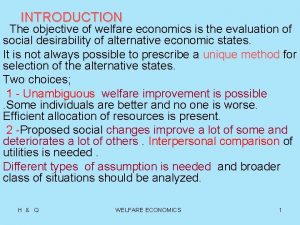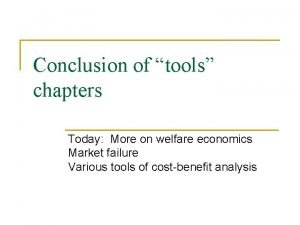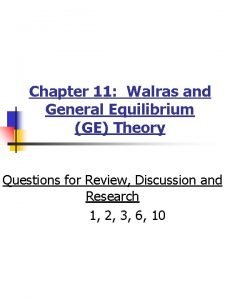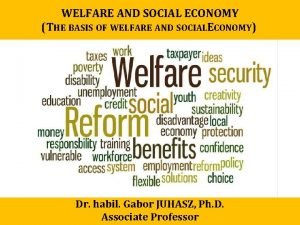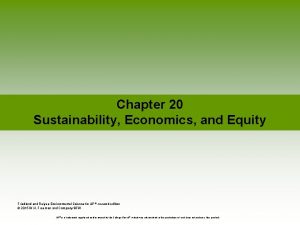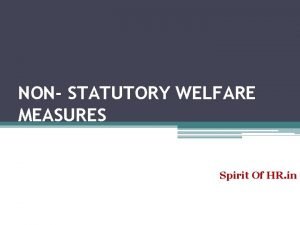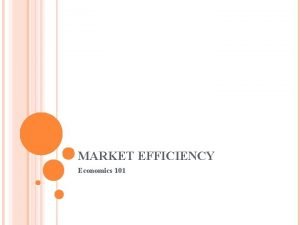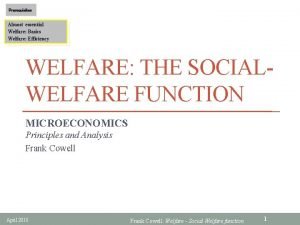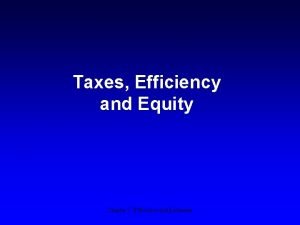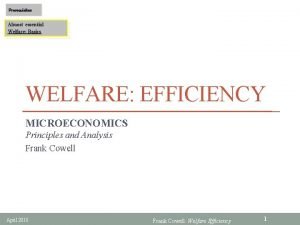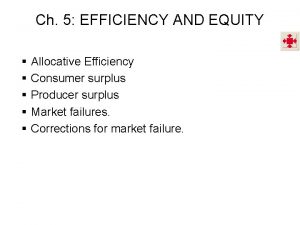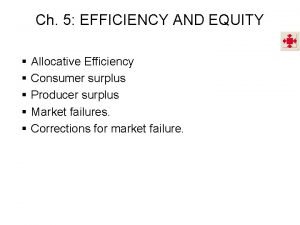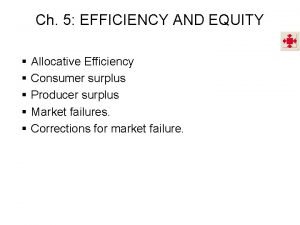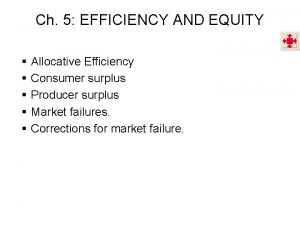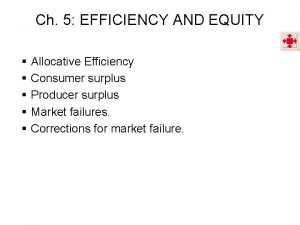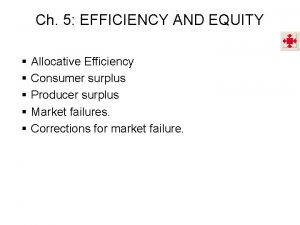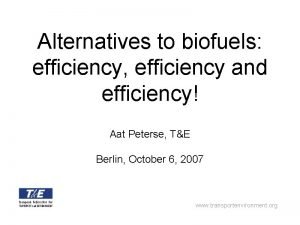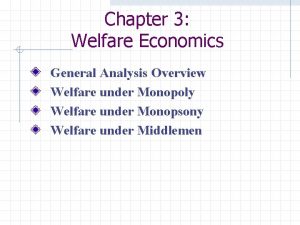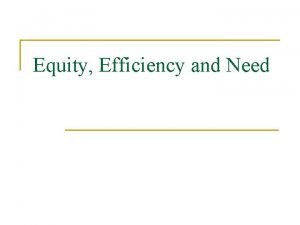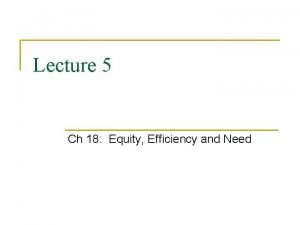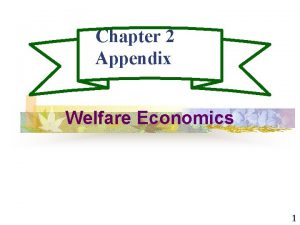Equity Efficiency and Need FSG 16 Welfare Economics































- Slides: 31

Equity, Efficiency and Need FSG 16

Welfare Economics n n n Concerned with how well an economy operates in terms of efficiency and equity/social justice Efficiency - allocation of resources Equity - distribution of income

Why Are We Concerned n Efficiency questions in health care sector arise because costs are high. n Equity questions arise because cost are high, and many people are uninsured or under insured.

Why Are We Concerned To really understand these concerns we need to: 1. Know the definition of efficiency 2. The assumptions behind efficiency 3. Role of equity

Outline n Pareto efficiency q q n n n Definition Edge-worth box First fundamental theorem of welfare Second fundamental theorem of welfare Assumptions behind the competitive equilibrium Theory of the second best Equity

Definition Pareto Efficiency Definition: 1. An economically efficient (optimal) outcome in society is one under which it is impossible to make someone better off without making someone worse off. 2. An efficient economy is one that has exhausted all means of mutual gains (trade)

Three Conditions for Efficiency n Consumption Efficiency q n Production Efficiency q n “maximum” utility “maximum” output Product-Mix (Substitution) Efficiency q optimum mix of commodities

Consumption Efficiency n n An allocation of commodities is consumption efficient if the only way to make one person better off is to make another person worse off. The MRS between each pair of goods must be equal for all consumers.

Edgeworth Box n Is a graphical tool used to understand what this definition of efficiency means. (rest of notes done on chalk board)

Consumption Efficiency Condition n The MRS between the two goods must be equal for all people 7

Production Efficiency n An allocation of inputs is production efficient if the only way to increase the output of one commodity is to decrease the output of another commodity

Production Efficient Allocations Slope of isoquant: Marginal Rate of Technical Substitute (MRTS) Capital Production efficient allocations Food 0' B 4 B 3 h B 2 k B 1 W 1 j W 2 W 3 0 Medicine W 4 Labour 6

Production Efficiency Condition n The MRTS between capital and labor must be equal for all commodities 7

Food Production Possibilities Curve MRT: show the amount of food that the economy must give up in order to gain an additional unit of medicine. h' k'Slope = Marginal Rate of Transformation (MRT) Medicine 9

Marginal Rate of Transformation n The MRT is the rate at which the economy can transform one output into another by shifting its resources q q the (negative of the) slope of the production possibilities curve If it equals 2, to have one additional unit of medicine, we need to give up two units of food 8

Product-Mix Efficiency n A mix of commodities is allocation efficient if the MRT between any two goods is equal to consumers’ common MRS between the two commodities. (the ratio in which goods are being produced is the same as people want to consume).

First Fundamental Theorem of Welfare Economics n Ø This theorem says: That an competitive equilibrium is Pareto efficient Great, so as long as we have a competitive market, our markets left all to themselves will be efficient –economists mean Pareto efficient. The famous “invisible hand solution”

First Fundamental Theorem of Welfare Economics But, 1. Is the health care market competitive? 2. Would a competitive market solution be equitable, or would there be a lot of people left with no health care? Lets address point 2 first, then come back to point 1.

Second Fundamental Theorem of Welfare Economics Things are not so bleak n Theorem states that given an appropriate endowment any Pareto efficient outcome can in principle be achieved n This means, that for any given endowment, we can redistribute the endowment to get to the efficient outcome we want (Back to chalk board)

How To Redistribute? Should we subsidize certain services? (health care) n We can but it is not consistent with Pareto efficiency. n Why? well to get to a Pareto efficient point, we had to find a tangency between both people’s indifference curve. n When everyone faces the same prices this will happen. n If they face different prices, there will not be a tangency point, i. e. there will be an inefficient outcome. n Income transfers are a superior way to redistribute because doesn‘t change prices

How To Redistribute n Some policy makers hesitate to make largescale income redistribution because of incentives. n Transferring wealth away for one group may provide a disincentive to work, and giving money to another group may provide a disincentive to work. q assumes we are only stimulated by money

Theory of the Second Best n Q 1: So should we try to adhere to as many of the assumptions as possible for competitive markets? n Q 2: Does removing a distortion of competitive markets make competitive markets work better? n Answer: Not necessarily q Theory of the Second Best tell us why

Theory of the Second Best n Say we have more than one departure from competitive market (more than one assumption does not hold). q n n Call this departure a distortion Now there is a policy that tries to correct on of these distortions. Theory of the Second Best says: that such a correction may not improve welfare i. e. we can’t assume welfare will be improved or that we get any closer to a competitive market.

Theory of the Second Best Classic Example: Polluting Monopolist n Suppose we have a monopolist who is in an industry where they make a lot of pollution due to the process of how the good is made. n Monopolist is a departure from perfect competition assumption. q Only one firm in the market not many. q First distortion n Polluter – pollution is a negative externality. q Second distortion n Monopoly prices are higher than under perfect competition and monopolists produce less than would be produced under perfect competition. q They can set prices because have market power

Theory of the Second Best Classic Example n Now, suppose we introduce more firms so the market is not a monopolistic anymore, but competitive (price takers). n Well if we do that, output will increase and prices go down, but the amount of pollution will also increase which could be a big problem. q So we made one problem better (prices) but another problem worse (pollution)

Theory of the Second Best Health Example Health example: licensure laws n Create a monopoly n At same time there is imperfect information in the market about quality of doctors. n If get rid of licensure laws, more doctors can practice, we may solve the monopoly problem. n But, there may be unqualified doctors and you may receive poor quality if not dangerous health care. q Problem in developing countries

Theory of the Second Best n Can’t assume that making the health care market look more like a competitive market will be a good thing. n Each policy and all the implications must be considered first and one should not implement a policy just because it promotes competition. n MANY policy makers fail to really realize this and don’t examine ALL implications. n One of the reasons economists don’t like politicians, they use our vocabulary as proof (i. e. competitive markets are efficient), but don’t use theory correctly.

Competitive Model Assumptions 1. Free entry and exit of firms q No barriers to entry 2. Perfect information of firms on consumers q You know the price of all doctors visits in Boulder and the quality of each doctor, and know what product you need. 3. A homogenous product q All doctors visits are the same 4. Lots of buyers and sellers out there so firms and consumers are price takers (perfect competition) q No one has market power

Competitive Model Assumptions 5. Consumers maximize their utility 6. Firms maximize profits 7. There are no significant externalities. Externality occurs if we receive benefits or are harmed by the actions of others. q n e. g. vaccinations

Competitive Model Assumptions Do they hold for health care? 1. Barriers to entry: licensure laws, price controls, facility construction is expensive. 2. Lots of buyers and seller: Not lots of hospitals in a town, so some degree of market power. Drugs on patents are a monopoly. 3. Firms max. profits: There is more than profit motivation out there (university hospitals often looking for prestige). There are not-forprofit hospitals. 4. No uncertainty: Lots of uncertainty in this market. q This is why we have insurance markets q This distorts prices so we are no longer efficient. q Often prices are negotiated between supplier and consumer, so price is not determine by the market

Competitive Model Assumptions Do they hold for health care? 5. Perfect information: There is not perfect information, we don’t know prices often! No externalities 6. q (i. e. vaccinations, viruses)
 Productive inefficiency and allocative inefficiency
Productive inefficiency and allocative inefficiency Allocative efficiency vs productive efficiency
Allocative efficiency vs productive efficiency Productive inefficiency and allocative inefficiency
Productive inefficiency and allocative inefficiency Fsg sob
Fsg sob Gymnasium fellbach
Gymnasium fellbach Mark bulle
Mark bulle Fsg alarm boiler
Fsg alarm boiler Dane smith fsg
Dane smith fsg Cmp
Cmp Fsg radio
Fsg radio Objectives of welfare economics
Objectives of welfare economics Conclusion of social welfare
Conclusion of social welfare Father of welfare economics
Father of welfare economics Roefie hueting
Roefie hueting Apes chapter 20 sustainability economics and equity
Apes chapter 20 sustainability economics and equity Ethics vs economics
Ethics vs economics School of business and economics maastricht
School of business and economics maastricht Mathematical economics vs non mathematical economics
Mathematical economics vs non mathematical economics Morale welfare and recreation
Morale welfare and recreation Voluntary health and welfare organization examples
Voluntary health and welfare organization examples National program related to child health and welfare
National program related to child health and welfare National child policy 1974
National child policy 1974 What is welfare
What is welfare Pros and cons of welfare state
Pros and cons of welfare state Ra no. 9344
Ra no. 9344 Cpi rational detachment
Cpi rational detachment Child welfare agencies in india
Child welfare agencies in india District integrated health and family welfare society
District integrated health and family welfare society Module 2 the animal world
Module 2 the animal world Agriculture cooperation and farmers welfare
Agriculture cooperation and farmers welfare Statutory and non statutory welfare measures
Statutory and non statutory welfare measures Plant cell vs animal cell venn diagram
Plant cell vs animal cell venn diagram










